Students can access the CBSE Sample Papers for Class 10 Science with Solutions and marking scheme Term 2 Set 4 will help students in understanding the difficulty level of the exam.
CBSE Sample Papers for Class 10 Science Term 2 Set 4 with Solutions
Time allowed: 2 Hours
Maximum Marks: 40
General Instructions:
- All questions are compulsory.
- The question paper has three sections and 15 questions. ALL questions are compulsory.
- Section-A has 7 questions of 2 marks each; Section-B has 6 questions of 3 marks each, and Section-C has 2 case based questions of 4 marks each.
- Internal choices have been provided in some questions. A student has to attempt only one of the alternatives in such questions.
Section – A
Question 1.
Why are natural ecosystems relatively balanced? If you remove all the phyto¬planktons from a pond what will happen to it? (2)
Answer:
A natural ecosystem is a balanced system because it consists of producers (green plants), herbivores (consumers I) carnivores (consumer II) and decomposers. Organisms of an ecosystem are well adjusted with biotic components. In the natural ecosystem, there is provision of constant flow of energy through the food chains and recycling of nutrients through decomposers. Thus, a natural ecosystem is a self-sufficient system.
False
Question 2.
Consider the following situations as shown in the diagrams.
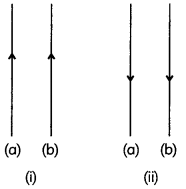
The arrows indicate the directions of current in the two closely kept parallel wires (a) and (b). The intensity of current in same in both wires. Use necessary diagram to a certain which pair of wires will attract and which will rule each others? (2)
OR
Look at the given situations and answer the following questions.
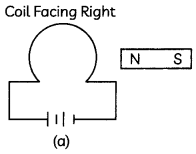
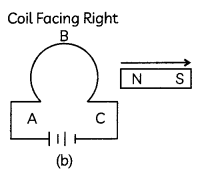
(A) In fig. (a) the coil is facing the right hand side which is towards the magnet. Will the magnet get attracted or repelled? Why? (1)
(B) In fig. (b) the coil is facing the right hand side which is towards the magnet. The magnet is moving away from the coil. What will be the direction of current in the coil? (1)
Answer:
Let us look at case (i)

As per Ampere’s Right hand thumb rule the direction of magnetic filed will be given as follows.
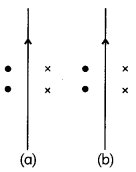
As can be seen in the central region of both wires the magnetic filed has opposite direction. Hence this pair will attract.
Let us now Look at case (ii)

Again involving Ampere’s Right hand thumb rule we see.
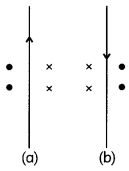
The magnetic field in the region between the wires is of the same polarity. Hence they will repel each other.
OR
(A) Let us draw the diagram
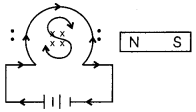
Using Ampere’s thumb rule we can see that the coil facing the magnet generates a South pole. Since the north pole of the bar magnet is facing the south pole of coil hence the bar magnet will get attracted.
(B) Let us draw the diagram
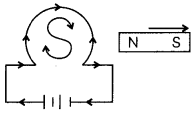
Since the bar magnet is moving away hence by the third law of electromagnetic induction, also known as Lenz law, the coil will be induced with a current that generates a polarity to stop the magnet from moving away. Since North pole is moving away hence the coil generates a south pole which then can be used along with Thumb rule to see that the flow of induced current will be along A → B → C.
Question 3.
A red haired woman marries a brown haired man, and all the children are brown haired.
Explain this genetically. (2)
Answer:
A red haired woman marries a brown haired man, and all the children are brown haired. The brown hair colour genes are dominant to the red hair colour genes. When there was exchange of gametes in male and female the dominant character was brown hair and recessive character was red hair. That is why the children were having brown coloured hairs.
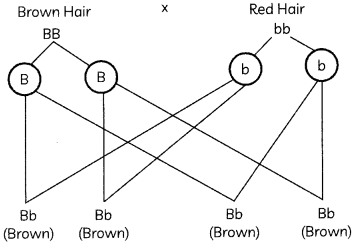
Question 4.
The given figure demonstrates the Periodic Table. Based on the figure, answer the following questions:

(A) Write a chemical reaction between R and S. (1)
(B) What type of ions will be formed by R and S? (1)
OR
The position of twelve elements in the Modern Periodic Table is given below where atomic numbers of elements are given in the parenthesis.
| Period | ||
| 2 | B (5) | C (6) |
| 3 | Al (13) | Si (14) |
| 4 | Ga (31) | Ge (32) |
| 5 | In (49) | Sn (50) |
(A) Predict the nature of Si and Ge. (1)
(B) Identify the element with smallest atomic radii. (1)
Answer:
(A) R belongs to group 2, period 3, thus it is Magnesium, (Mg) and S belongs to group 17, period 3, thus it is Chlorine (Cl).
Mg + Cl
2
→ MgCl
2
i.e. R + S
2
→ RS
2
(B) As R belongs to Group 2, thus it has two valence electrons which it can easily lose to attain stable configuration. Thus, R will form a dipositive cation, R
2+
. S belongs to group 17 of the periodic table, thus it has seven valence electrons. It only requires one more electron to attain stable configuration. Thus, S will form a uni-negative anion, S
–
.
OR
(A) Si and Ge fall under the category of metalloids as they fall under group 14 and 3
rd
and 4
th
period.
(B) From the given table, C has the smallest atomic radii based on the atomic radii trend.
Question 5.
In the given figure, identify the following parts:
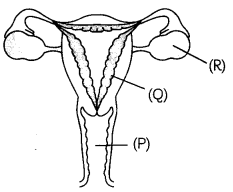
(A) Part from where entry of sperms take place. (1/2)
(B) Site of implantation. (1/2)
(C) Organ where production of egg takes place. Write one more functions of labelled part (R). (1)
OR
List the changes which take place in given figure of a bisexual flower after fertilisation. (2)
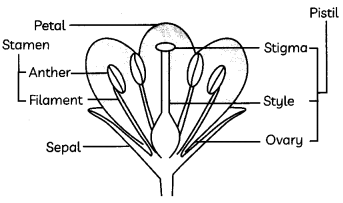
Answer:
(A) P-Vagina
(B) Q-Uterus
(C) R-Ovary
Function of Ovary: Ovary produces the female hormone estrogen which is responsible for all the changes taking place in a girl during puberty.
OR
After fertilisation, zygote divides several times to form an embryo within the ovule. The ovule develops a tough coat and is gradually converted into a seed. The ovary grows rapidly and ripens to form a fruit. The petals, sepals, stamens, style and stigma may shrivel and fall off.
Question 6.
Using the part of the periodic table given below answer the questions that follows:
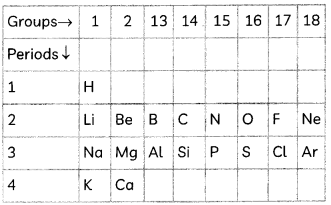
The netural atom of an element E consists of 12 electrons in its atoms.
(A) In which period and group is E placed? (1/2)
Answer:
As the atom is neutral, therefore, the number of electrons is equal to the number of protons which reflects the atomic number of element E. Element E has atomic number equal to 12, thus its electronic configuration is 2, 8, 2. Based on the configuration, Element E belongs to 3rd period and 2nd group.
(B) Name the element E. (1/2)
Answer:
The element has atomic number 12 so its Magnesium, Mg.
(C) How many electrons E needs to lose or gain to achieve noble gas configuration. (1/2)
Answer:
As the electronic configuration of Mg is 2,8,2, it can easily lose the two valence electrons to attain stable noble gas configuration of Neon.
(D) Write the formulae of chloride of E? (1/2)
Answer:
The valency of Mg is 2 according to the combining capacity. Thus, the formula of its chloride will be:

Question 7.
(A) Sperm and eggs are the reproductive units of humans. In what way are sperms and eggs of humans different? Write the importance of this difference. (1)
Answer:
The main difference lies in the difference in the sex chromosome of sperm (male gamete) and egg (female gamete). The main difference between sperms and eggs of humans is that half of the sperms of a male (father) will have X chromosomes and the other half will have Y chromosomes. All the eggs of female (mother) will have only X chromosomes. The importance of this variation are
(i) If the father contributes X chromosome, then the baby born will be a girl.
(ii) If the father contributes Y chromosome, then the baby born will be a boy. Thus, the sperm determines the sex of a child.
(B) Give the common name and scientific name of the plant on which Mendel performed its experiments. (1)
Answer:
The common name of the plant on which Mendel performed his experiments is Pea plant. It’s scientific name is Pisum Sativum.
Section – B
Question 8.
(A) How is the direction of magnetic field at a point determined? (1)
Answer:
The direction of the magnetic field at a point can be found by placing a small magnetic compass at that point. The north end of the needle of a compass indicates the direction of magnetic field at a point where it is placed.
(B) What is the direction of magnetic field at the centre of a current-carrying circular loop? (1)
Answer:
The direction of magnetic field at the centre of a current-carrying circular loop is perpendicular to the plane of the loop.
(C) (i) What is the role of the split ring in an electric motor?
(ii) What is the role of carbon brush in a motor ? (1)
Answer:
(i) In an electric motor, the split ring acts as commutator. Due to its action, the direction of current flowing in motor coil reverses after half turn, giving rise to a continuous rotation of the coil and the axle.
(ii) A carbon brush is essentially a graphite brush which allows the passage of curent from the external source to the rotating split rings while maintaining lubrication against wear and tear.
Question 9.
(A) Identify and name the third member of the alkane family and write its formula. (1½)
(B) Explain with appropriate reasons as to how many isomers are possible with the third member of the alkane family. (1\(\frac{1}{2}\))
OR
In electron dot structure, the valence shell electrons are represented by crosses or dots.
(A) The atomic number of chlorine is 17. Write its electronic configuration. (1½)
(B) Draw the electron dot structure of chlorine molecule. (1½)
Answer:
(A) The general formula of the alkane family is C
n
H
2n+2
. Here value of n = 3, thus, the formula for the third member of the alkane family is C
3
H
8
and is called propane.
(B) Isomers are compounds with same molecular formula and different structural formula. Propane has only three carbon atoms which is not sufficient enough to exist in a branched form. Thus, propane does not exhibit isomerism.
OR
(A) The atomic number of chlorine atom is 17. Hence, the electronic configuration of Cl (17) would be:
![]()
(B) Chlorine molecule is formed by the formation of a single covalent bond between two chlorine atoms. The electron dot structure of chlorine molecule is:

Question 10.
Study the following circuit and answer the questions that follows:
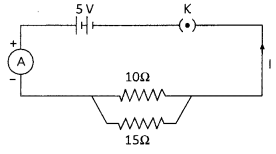
(A) State the type of combination of two resistors in the circuit. (1)
(B) How much current is flowing through 0 10 ohms and (ii) 15 ohms resistor? (1)
(C) What is the ammeter reading? (1)
OR
Determine the following quantities for the circuit shown in the given figure:

(A) The equivalent resistance (1)
(B) The total current from the power supply and the current through each resistor (1)
(C) The voltage drop across each resistor and the power dissipated in each resistor (1)
Answer:
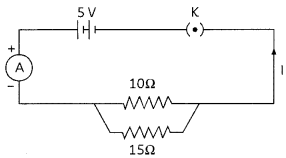
(A) Resistors in the circuit are connected in parallel combination.
(B) (i) Let Ii be the current flowing through
R
1
= 10 ohm.
Now I
1
R
1
= V
I
1
= \(\frac{V}{R_{1}}=\frac{5}{10}\) = 0.5A
(ii) Let I2 be the current flowing through
R
2
= 15 ohm
Now I
2
R
2
= V
I
2
= \(\frac{V}{R_{2}}=\frac{5}{15}\) = 0.33A
(C) Ammeter reading
= I
1
+ I
2
= 0.5 A + 0.33 A
= 0.83 A
OR
Given circuit diagram:

(A) Equivalent resistance:
Resistances in series add up.
R = R
1
+ R
2
+ R
3
= 20Ω + 30Ω + 50Ω
= 1ooΩ
(B) Total current from the power supply:
Total current is determined by the voltage of the power supply and the equivalent resistance of the circuit.
I = \(\frac{V}{R}\) = \(\frac{125}{100}\) = 1.25 A
Current through each resistor:
Current is constant through resistors connected in series.
(C) Voltage drop across each resistor:
V
1
= IR
1
= 1.25A × 20Ω = 25 V
V
2
= IR
2
= 1.25A × 30Ω = 37.5 V
V
3
= IR
3
= 1.25A × 50Ω = 62.5 V
In a series circuit they should equal the voltage increase of the power supply.
V
total
= V
1
+ V
2
+ V
3
125 V = 25 V+37.5 V+62.5 V
125 V = 125 V
The power dissipated in each resistor:
P1 = V
1
× I
1
= 25V × 1.25A
= 31.250 W
P2 = V
2
× I
2
= 37.5V × 1.25A
= 46.875 W
P3 = V
3
× I
3
= 62.5V × 1.25A
= 78.125 W
Question 11.
(A) Among all the periods, which one is incomplete and what are the important properties exhibited by all elements present in this period? (1)
Answer:
With reference to the Modern Periodic Table, the 7th period is incomplete even though it has 32 elements. It is because it consists of elements whose properties are not yet studied properly. One of the important characteristic of elements in this period are that they are radioactive in nature.
(B) When a Dobereiner triad is considered, the sum of atomic masses of extreme elements X and Z is 177.6 and difference of Z and Y is five times the number of protons present in neon atom. Identify X, Y and Z. (2)
Answer:
As given in the numerical,
Sum of atomic masses of extreme elements X and Z = 177.6
Difference of atomic masses. Z and Y = 5 × (Number of protons in Ne)
= 5 × 10 = 50
As X, Y and Z are Dobereiner’s triad, the sum of atomic masses of X and Z is 177.6 and the atomic mass of Y will be average of atomic masses of X and Z according to Dobereiner’s principle.
Atomic mass of Y = Avg. of atomic masses ofX and Z
= 177.6/2
= 88.8
Now the difference between Z and Y = 50
Substituting the value of Y = 88.8 in above equation, we get
Z – Y = 50
Z = 50 + Y
Z = 50 + 88.8
Z = 138.8
Now, substituting the values of Z and Y, we get the value of X
Atomic mass of Y = Avg of atomic masses of X and Z
88.8 = \(\frac{\begin{array}{c}
\text { atomic mass of } X+ \\
\text { atomic mass of } Z
\end{array}}{2}\)
= \(\frac{\text { Mass of } X+138.8}{2}\)
177.6 = Mass of X + 138.8
Mass of X = 177.6 – 138.8
= 38.8
Therefore, the elements X, Y and Z are Ca, Sr and Ba respectively which are elements of Dobereiner’s triads.
Question 12.
(A) If you collect a sample of water from lake or pond, you will find green filamentous organisms. Identify the organism and their mode of reproduction. (1)
Answer:
Organism is Spirogyra and mode of reproduction is fragmentation.
Related Theory:
Spirogyra simply breaks up into smaller pieces upon maturation. These pieces or fragments grow into new individuals.
Caution:
Do not confuse between fragmentation and regeneration. Regeneration is an ability of the organism to restore the amputed portion of the body.
(B) A stale bread will have fungal growth on it. You can observe the tiny blob-on- a-stick structures sitting on the hyphae. Name the blob structures. (1)
Answer:
Sporangia
Related Theory:
The blob structures are sporangia, which contain cells, or spores, that can eventually develop into new Rhizopus individuals.
(C) Some flowers have either stamen or pistil Can you give any two examples of such flowers? (1)
Answer:
Papaya and Watermelon
Related Theory:
Papaya and watermelon are unisexual flowers. They either contain stamen or pistil.
Question 13.
A non-biodegradable toxic chemical has entered into the food chain. Which type of food habit would you suggest to a man, vegetarian or non-vegetarian? Explain with the help of a food chain the food chain which you would suggest, is advantageous in another aspect. How? (3)
Answer:
Vegetarian food chain will be suggested in case of entry of non-biodegradable toxic chemicals into the food chain.
Non-biodegradnble chemicals get concentrated at every trophic level by the process of biological magnification. As the concentration increases with the number of trophic level in food chain, man will get high concentration of the chemicals in non-vegetarian food chain than in vegetarian food chain e.g.
Vegetarian food chain:

Non Vegetarian food chain:

90% of energy is lost in the environment, at every trophic level, a lesser number of trophic levels will result in lesser energy loss.
Section – C
False
Question 14.
Fragmentation and regeneration are two different modes of reproduction. During fragmentation an organism on maturation splits which enables the creation of new individuals from the fragments. While, regeneration occurs where the organism has an ability to regrow certain parts of its body when it loses them. In some organisms, only certain specialized cells, proliferate making regeneration possible.
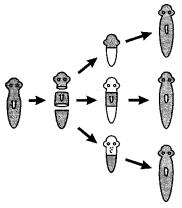
(A) Identify the organism and process shown in the figure. (1)
(B) Do you think humans can reproduce by
the fragmentation mode? (1)
(C) Do you think regeneration is same as reproduction? Justify your answer. (2)
OR
(C) (i) Sheela’s teacher explained the class that young boys and girls of 12-14 age undergo various physical changes. These changes are necessary and is an onset of adulthood. However, Sheela has not experienced any changes yet. She is curious to know about puberty and the changes that can take place in females during puberty. What are those changes? (1)
(ii) Male reproductive system is a complex network of various organs. Each organ has an important role to play. Which parts of human male reproductive system contribute fluid to the semen? Why do you think addition of semen is advantageous? (1)
Answer:
(A) The organims’is Planaria and the process shown in the figure is regeneration in Planaria.
Falk: cell-by-cell division would be impractical in many multi-cellular organisms . Falk: many multi-cellular organisms are not simply a random collection of cells . cells are organised as tissues, and tissues are organised into organs, he says . Falk: in such a carefully organised situation, cell-by-cell division would be impractical .
(C) Regeneration is not the same as reproduction since most organisms would not normally depend on being cut up to be able to reproduce.
Also, in certain organisms, only a portion of the organism is regenerated, rather than the entire organism (Example, tail of a lizard can be regenerated). Reproduction, on the other hand, entails the creation of a completely new creature. As a result, we can distinguish between regeneration and reproduction.
OR
(C) (i) The period when the rate of general body growth begins to slow down and reproductive tissues begin to mature, is called puberty. Two changes observed in girls at the time of puberty are:
(a) the breast size begin to increase,
(b) menstruation starts
(c) hair growth in the pubic areas
Related Theory:
Adolescent and menstruating age might vary from person to person. It depends on various factors like heredity, nutrition, life-style, etc.
ii) Prostate glands and seminal vesicles add fluid in the vas deferens . this makes transportation of sperms easier and also provides nutrition to the sperms .
Question 15.
For the flow of charge in a conductor metallic wire, gravity does not play any role. The electron moves only if there is a difference in electric potential. The chemical action with a cell generate the potential difference across the terminal of the cell, even when no current is drawn from it, potential difference set the charges in motion in the conductor produce an electric current, the cell has to expend its chemical energy stored in it
(A) We know that in conventional current positive charges move from higher potential to lower potential But we also know that the only positive charge in a conducting wire is the proton which is trapped inside the nucleus. So which particle is actually moving? How do you reconcile this knowledge with what you’ve studied about conventional current? (1)
(B) A charge of 10 coulombs is flowing through a wire for 10 minutes. If the work done is 10000 J, what is the resistance of the wire? (1)
(C) If the resistance of a wire is tripled without changing the nature of material or length of the wire, then what was changed and by how much? (2)
OR
Find the minimum resistance that can be made using five resistors each of 1/5 Ω.
Answer:
(A) In conductors it is the electrons which flow from lower potential to higher potential. This is known as electric current. Conventional current is the direction of electric current from the positive terminal of a cell to the negative terminal. Also electric current defines the direction of flow of opposite charges in a circuit. The protons don’t take part in the flow electric current at all.
(B) Given:
Q = 10 C,
t = 10 min = 600 s,
W = 10000 J.
We know that
W = VIt.
I = Q/t
and V = IR.
When combined we get
W = Q
2
R/t.
Hence, R = Wt/Q
2
Hence, R = 10000 × 600/100
= 60000 Ohms.
(C) If the nature of material and length remains constant and yet the resistance changes then it means the area was changed. Since area is inversely proportional to the resistance hence the area was decreased to one-third of its actual value.
OR
For getting minimum resistance R we can connect five resistors in parallel combination.
Resistance of each part = \(\frac{1}{5}\)
Resistance are connected in parallel to have minimum resistance.
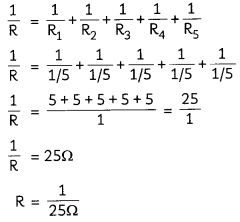
So, the minimum resistance that can be made by using five resistors each of \(\frac{1}{5}\)Ω is \(\frac{1}{25}\)Ω.